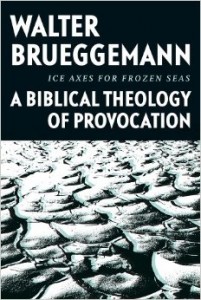“Ice Axes for Frozen Seas” Excerpt 1
 From Ice Axes for Frozen Seas: A Biblical Theology of Provocation by Walter Brueggemann. Copyright © 2014 by Baylor University Press. Reprinted by arrangement with Baylor University Press. All rights reserved.
From Ice Axes for Frozen Seas: A Biblical Theology of Provocation by Walter Brueggemann. Copyright © 2014 by Baylor University Press. Reprinted by arrangement with Baylor University Press. All rights reserved.
I think I understand the double accent on hopeful because we live in a society (and church) that is overwhelmed by the “data of despair” all around us, with no one knowing where to turn next. The facts on the ground, moreover, are situated in a narrative of despair that I have termed “military consumerism,” a preoccupation with satiation and self-indulgence about commodities that is reinforced by a military muscle that aims to protect our entitled advantage in the world. It is clear that that narrative, which dominates the imagination among us, is not hope-filled, because it cannot make us either safe or happy. It is clear that the world generated by the narrative of “military consumerism” holds no human future for us. And it is unmistakable among preachers of every ilk that that dominant narrative cannot be easily critiqued because it functions in our society as an unquestioned religious totem. We are pressed elsewhere for hope; that, however, is not so clear, given the powerful combination of the facts on the ground and the narrative of despair that converge in concrete ways among us.
I am, moreover, impressed that Walter May’s mandate to me twice used the word “narrative,” “narrative of hope and faithfulness in the Old Testament” in the service of a “narrative of hopeful, inclusive ministry.” It is clear against both Enlightenment reason and fundamentalist reductionism that there is no tight settled edict that could yield sustainable hope. Rather hope arises precisely through the narrative process in which we tell and retell our lives.1 Thus narrative has privilege as a mode for the substance of faith because we tell a story in which newness emerges specifically and concretely in a way that cannot be explained or controlled. Thus the question among us is, “What story shall we tell?” given that the dominant story we tell allows for no news to emerge, precisely because we are bent on explanatory control. A controlled story, one in which we know the end before we start telling, is no venue for hope.
When a Christian preacher or teacher asks about narratives of hope, we are drawn to the big narratives:
“My father was a wandering Aramean” as the defining story of ancient Israel, a story that culminates with gratitude for the new land.
The Pauline summary of faith grounded in Scripture:
For I handed on to you as of first importance what I in turn had received: that Christ died for our sins in accordance with the scriptures, and that he was buried, and that he was raised on the third day in accordance with the scriptures, and that he appeared to Cephas, then to the twelve. Then he appeared to more than five hundred brothers and sisters at one time, most of whom are alive, though some have died. Then he appeared to James, and then to all the apostles. Last of all, as to one untimely born, he appeared also to me. (1 Cor 15:3-8)
The eucharistic mystery of faith:
Christ has died,
Christ is risen,
Christ will come again.
And eventually we come to the creeds that pivot on that awesome phrase, “and was made man.”
But of course the big narratives, in order to be pastorally compelling, emerge in small pastoral venues that well up in the concrete lives of the faithful. I submit that in all of these small venues, widely variant as they are, the defining connection is between bodily reality (of life, suffering, and death) and holy mystery that we cannot articulate with any precision but that matters decisively to us. It is the wonder of our faith—and of the stories we tell—that bodily reality and holy mystery make contact, not unlike that instant of contact between God and Adam sketched by Michelangelo in the Sistine Chapel. To tell a surprising, compelling interaction of bodily reality and holy mystery, we situate our immediate narrative and shape it according to the remembered narrative of that same interface that we cannot explain but to which we bear witness. Thus I assume that in telling and in hearing such a tale that yields newness, we inescapably move back and forth between what we remember from previous tellings and what we know in the present tense of our own bodily contact with that holy mystery. So I take my assignment to tell a tale of hope that is a remembered story in which newness emerged at the mix of body and holy. As we tell and hear such a remembered story, we let the memory become present tense among us and find the pulse of new possibility that is in part God-given and in part humanly felt and discerned.
Additional excerpts and a giveaway contest coming soon. Stay tuned!
0 Comments